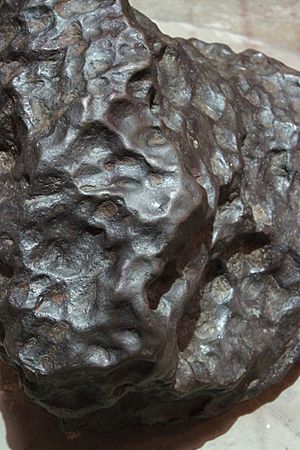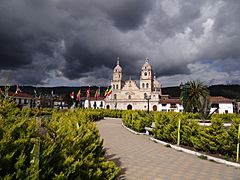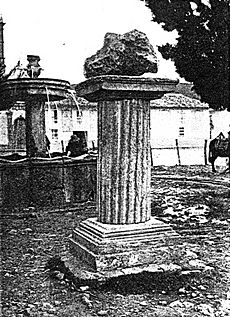Santa Rosa de Viterbo meteorite facts for kids
Quick facts for kids Aerolito de Santa Rosa de Viterbo |
|
|---|---|

A 411 kg fragment of the meteorite in the Colombian National Museum
|
|
| Country | Colombia |
| Region | Boyacá |
| Observed fall | No |
| Found date | 1810 |
| TKW | >700 kilograms (1,500 lb) |

Santa Rosa de Viterbo in north central Boyacá, the town of the meteorite fall
|
|
| [[Commons:Category:Lua error in Module:Wikidata at line 70: attempt to index field 'wikibase' (a nil value). |Related media on Wikimedia Commons]] | |
The Santa Rosa de Viterbo Meteorite is a famous space rock found in 1810. It was discovered on Tocavita Hill, close to the town of Santa Rosa de Viterbo in the central part of Boyacá, Colombia. This meteorite is a very important piece of history and science for Colombia.
Discovering the Meteorite
In early 1810, on a day called Holy Saturday, a woman named Cecilia Corredor found this large meteorite. She discovered it near the town of Santa Rosa de Viterbo, on Tocavita Hill.
After it was found, the meteorite was moved to the center of Santa Rosa de Viterbo. For a long time, it was used as an anvil in the town's metal workshop. An anvil is a heavy block of metal that blacksmiths use to shape other metals with a hammer.
On September 8, 1877, the town's mayor decided to display the meteorite. He had it placed on a stone stand in the town's main park for everyone to see.
Later, during the time when Rafael Reyes Prieto was the president of Colombia, the meteorite was moved to Bogotá, the capital city. There, it was carefully cut into two main pieces. One piece was placed in the Colombian National Museum, which is a very important museum. The other piece was sent to museums in other countries.
Years later, a group of Jesuits (members of a religious order) found three more smaller pieces of the same meteorite. This showed that the original meteorite was even larger than first thought!
Where the Meteorite Pieces Are Now
When the Santa Rosa de Viterbo Meteorite was first moved from the town's main park to Bogotá, it was divided into two large parts.
- One piece, which weighs 411 kilograms (about 906 pounds), stayed in Bogotá. You can still see it today at the Colombian National Museum.
- The other large piece was sent abroad to be shown in museums in other countries.
The other smaller pieces that were found later are kept in different universities in Colombia. These include the Pontifical Xavierian University, the National University of Colombia, and La Salle University. Scientists and students can study these pieces to learn more about space and meteorites.
See also
 In Spanish: Santa Rosa de Viterbo (meteorito) para niños
In Spanish: Santa Rosa de Viterbo (meteorito) para niños


